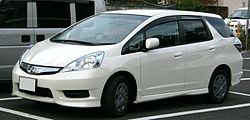Top Qs
Timeline
Chat
Perspective
Honda Fit Shuttle
Motor vehicle From Wikipedia, the free encyclopedia
Remove ads
The Honda Fit Shuttle is a subcompact car which was made by Honda from May 2011 until August 2022 over two generations. A Japanese domestic market model, the Shuttle is a five-door station wagon derived from the Fit. The first generation served as successor the Airwave, also derived from the Fit.[1] The second generation entered production in April 2015. The Fit Shuttle has a front-mounted engine and either front-wheel drive or four-wheel drive, with petrol engined and petrol-electric hybrid variants.
Remove ads
First generation (GG7/8/GP2; 2011–2015)
Summarize
Perspective
The launch of the car in June 2011 was pushed back from March as a result of the earthquake and tsunami in Japan on March 11, 2011. Production of the car was transferred from Honda's Sayama plant in Saitama Prefecture to Suzuka plant in Mie Prefecture as a result of power rationing after the quake.[contradictory] Production began in early May 2011.[4][5] The Fit Shuttle was shortlisted for Car of The Year Japan 2012.[6]
Its drivetrains are shared with the Fit. The Fit Shuttle has a 1.5 L i-VTEC engine with 120 PS (88 kW), which is optional on the Japanese-market Fit. A hybrid version, the Fit Shuttle Hybrid, is also available, with a 1.3 L i-VTEC engine with IMA. This has 88 PS (65 kW) plus 14 PS (10 kW) from the electric motor. Continuously variable transmission is the only transmission available for FWD models. A five-speed automatic transmission is standard on four-wheel-drive models.
The fuel efficiency of the station wagon and its hybrid variant was enhanced to be the same as that of Fit and Fit hybrid by reducing engine friction, front brake rolling resistance, improvement in aerodynamics and improvement of control efficiency of the hybrid system. All models feature ECON Mode for enhancing real-world fuel economy. Hybrid model has Eco Assist (Ecological Drive Assist System) to help the driver engage in fuel-efficient driving practices. It went on sale on June 16, 2011, in Japan.[1]
The Fit Shuttle comes with a double-hinged two-piece load floor that both allows access to an under-floor storage bin and also functions as a divider for the cargo area. The regular luggage compartment in front-wheel drive variants holds 496 L (17.5 cu ft), while the underfloor compartment holds 94 L (3.3 cu ft). The hybrid version keeps batteries in this area, limiting the underfloor space to 21 L (0.74 cu ft).[7] 4WD models have a single, compartment and no underfloor space.[8] Through better sound dampening and insulation, the Fit Shuttle is pledged to be as quiet as a mid-size sedan.[9]
Remove ads
Second generation (GK8/9/GP7/8; 2015–2022)
Summarize
Perspective
The second generation model was sold and renamed as the Honda Shuttle, unlike the previous generation model and is still similarly based with the Honda Fit. Honda had begun sales of the all-new Shuttle at dealerships across Japan on May 15, 2015, with the compact wagon starting from 1,990,000 yen.[11]
The Honda Shuttle is available with either an 132 PS (130 hp; 97 kW) 1.5-litre direct-injection DOHC i-VTEC petrol engine mated to a CVT or a hybrid version equipped with the Sport Hybrid i-DCD system.[12]
The latter pairs a 1.5-litre Atkinson cycle DOHC i-VTEC petrol engine with an electric motor integrated into the 7-speed DCT transmission and a battery pack and has a combined system output of 137 PS (135 hp; 101 kW). It is available in G, Hybrid base, Hybrid X and Hybrid Z trim levels with Honda Sensing as standard.
Honda says the Shuttle Hybrid averages 34 km/L (2.9 litres per 100 kilometres; 80 miles per US gallon) according to the JC08 standard. For the first time, the Shuttle is also offered with a four-wheel drive option.[contradictory]
It received a facelift on May 10, 2019, featuring redesigned bumpers and revised rear tail lamps that stretch towards the centre of the tailgate. The seats were also redesigned.
Production of the Shuttle ended in August 2022, and it was discontinued on November 10, 2022.
Remove ads
Sales
In June 2011, Honda originally set a monthly sales target at 4,000 units for the Shuttle. The first generation handily exceeded this goal, selling in 6-digit number figures – however, the second generation declined considerably in sales, dropping by about 80 percent.
References
External links
Wikiwand - on
Seamless Wikipedia browsing. On steroids.
Remove ads











